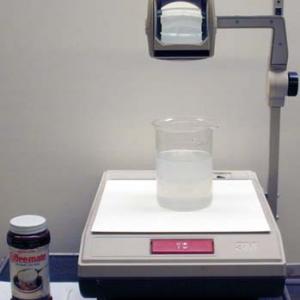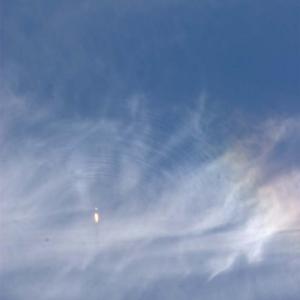College of Liberal Arts & Sciences
6F40.10 - Distortion due to Atmospheric Scattering
See also 6F40.10 in Astronomy.
Place the masking plate on the overhead projector. Place the beaker of water over the hole in the masking plate. Start adding small amounts of coffee creamer and stirring. As more coffee creamer is added the color projected from the overhead should go from white to orange to yellow and then eventually to extinction. During this process, you may insert different color filters between the light source and the beaker and observe how far each color travels into the beaker before it is absorbed or scattered. If you put a mask on the overhead projector that has a hole in it that is much smaller than the diameter of the beaker you will observe a beam of light up through the beaker. You can then use a Polarizer from the side of the beaker to observe and then extinguish that beam.
Hook the light bulb to the Variac. Place the light bulb in the blacked box. Hold the screens in front of the light and observe that the screens with greater amounts of particles give the fuzziest image (Atmospheric Scattering).
A couple of drops of Pine-Sol can be used in place of the creamer. This is a timed reaction so it will take up to one min. for the solution to turn cloudy.
For a "timed" sunset, you can use a mixture of sodium thiosulfate and hydrochloric or sulfuric acid. Mix the thiosulfate with water until you have a saturated solution. When ready to use, dilute this saturated solution with 10 parts water. Make another solution with 2 ml of hydrochloric acid in 400 ml of water. Pour 50 ml of this into the diluted thiosulfate solution and observe the precipitation rate (This should turn milky white within 30 seconds). Dilute one or both of the solutions further until the desired reaction rate is obtained.
A more complicated way to create the scattering particles is to make two solutions. Solution 1 is 25 g of sodium thiosulfate in 500 ml of distilled or filtered H20. Solution 2 is 1.5 ml of concentrated HCL to 500 ml of water. When ready, add the two solutions together on the overhead projector. The transmitted light should go from white to yellow to orange to red and eventually extinction. This process will take about 1 minute. If you wish to slow the reaction time down to about 3 minutes, use only 15 g of sodium thiosulfate when making solution 1. Note that as these two solutions are mixed, it is the colloidal sulfur precipitate that are the scattering particles.
A simple alternative for this demo is to use a small Maglite with a clear hot melt glue stick. You will observe the blue light scattering out the side and the red light exiting from the end of the glue stick.
This demonstration can also be used to help explain the zodiacal light which is Sunlight scattered by interplanetary dust.
- James Lincoln, "Ten Annoying Experiments to do at Dinnertime", TPT, Vol. 63, #2, Feb. 2025, p. 136.
- Jennifer J. Birriel, "Close Encounters of the "Light" Kind", TPT, Vol. 63, #1, Jan. 2025, p. 78.
- Robert Hobbs, "Sunset in a Tube Demonstration", TPT, Vol. 61, #9, Dec. 2023, p. 806.
- Chris Chiaverina, "There Goes the Sun: Sunset Simulations Old and New", TPT, Vol. 59, #1, Jan. 2021, p. 74.
- Figuring Physics, TPT, Vol. 50, # 6, Sept. 2012, p. 330.
- Michael Liebl, "Blue Skies, Coffee Creamer, and Rayleigh Scattering", TPT, Vol. 48, # 5, May 2010, p. 300.
- Gregory A. Dilisi, Colleen M. Winters, Lori A. Dilisi, Kristina M. Peckinpaugh, " A Beer's Law Experiment", TPT, Vol. 43, # 3, March 2005, p. 144 - 147.
- E-Qing Zhu and Se-yuen Mak, "Demonstrating Colors of Sky and Sunset", TPT, Vol. 32, # 7, p. 420- 421, Oct. 1994.
- Paul Changnon, "Animated Displays IV: Linear Polarization", TPT, Vol. 31, # 8, Nov. 1993, p. 489 and referenced in Resource Letter TLC-1 Teaching Light and Color, Demonstration Experiments Resource Articles.
- William R. Kuhn and Susan E. Postawko, "Solar Radiation and the Earth's Atmosphere", TPT, Vol. 26, # 5, p. 266, May 1988.
- Craig F. Bohren and Alistair B. Fraser, "Colors of the Sky", TPT, Vol. 23, # 5, p. 267, May 1985.
- Joe Ferguson, "Dye Blue is Not Sky", TPT, Vol. 16, # 4, Apr. 1978, p. 243.
- Thomas A. Mitchell, "Why is the Sky Blue and the Sunset Red?", TPT, Vol. 16, # 5, May 1978, p. 282.
- Ben M. Doughty, A Pinch of Coffee-Mate", TPT, Vol. 12, # 2, Feb. 1974, p. 132.
- Marla H. Moore, "Blue Sky and Red Sunsets", TPT, Vol. 11, # 7, Oct. 1973, p. 436.
- Haym Kruglak, "A Simplified Sunset Demonstration", TPT, Vol. 11, # 9, Dec. 1973, p. 559.
- Glenn S. Smith, "Summing the Molecular Contributions to Skylight", AJP, Vol. 76, # 9, p. 816, Sept. 2008.
- A. J. Cox, Alan J. DeWeerd, Jennifer Linden, "An Experiment to Measure Mie and Rayleigh Total Scattering Cross Sections", AJP, Vol. 70, # 6, June 2002, p. 620.
- Charles L. Adler, James A. Lock, "A Simple Demonstration of Mie Scattering Using an Overhead Projector", AJP, Vol. 70, # 1, Jan. 2002, p. 91.
- Craig F. Bohren and Alistair B. Fraser, "At What Altitude Does the Horizon Cease to be Visible?", AJP, p. 222, Vol. 54, No. 3, March 1986.
- Thomas T. Arny, "Demonstrating Atmospheric Diffraction Rings with a Tensor Lamp", AJP, p. 87, Vol. 55, No. 1, Jan. 1987.
- B. G. Eaton and John B. Johnston. "More About Light Scattering Demonstrations", AJP, 184, Vol. 53, No. 2, Feb. 1985.
- W. S. Moore, "A Multipurpose Laser Demonstration Experiment", AJP, Vol. 39, #12, Dec. 1971, p. 1536.
- On-1: Freier and Anderson, A Demonstration Handbook for Physics.
- O-040: "Simulated Sunset", DICK and RAE Physics Demo Notebook.
- O-615: "Blue Sky and Powdered Cream", DICK and RAE Physics Demo Notebook.
- Tik Liem, "The Confused Flashlight", Investigation to Science Inquiry, p. 289.
- Tik Liem, "The Simulated Sunset", Investigation to Science Inquiry, p. 288.
- Johanna Miller, "Shaped Light Waves can Pass Through Opaque Material", Physics Today, September 2008, p. 20.
- Andy Gavin, "Polarization Mystery", Tap-L e-mail, Tuesday, July 14th, 2009.
- "The Pleiades Nebulae Cocktail", 6F40.11, ASU (Arizona State University) Demo Room, ( Sodium Thiosulfate demo).
- Janice VanCleave, "Demonstrate the Scattering of Light", Super Science Challenges, p. 134.
- Martin C. Sagendorf, "Why is the Sunrise/Sunset 'Red/Orange' in Color?", Physics Demonstration Apparatus, 2009. p. 31.
- Jearl Walker, "6.112, Color of Campfire Smoke", The Flying Circus of Physics Ed. 2, p. 288.
- Jearl Walker, "6.111, Color of Milk in Water", The Flying Circus of Physics Ed. 2, p. 287.
- Jearl Walker, "6.11, Sky Colors During a Solar Eclipse", The Flying Circus of Physics Ed. 2, p. 246.
- Jearl Walker, "6.9, Bishop's Ring", The Flying Circus of Physics Ed. 2, p. 246.
- Jearl Walker, "6.8, Sunsets and Volcanoes", The Flying Circus of Physics Ed. 2, p. 246.
- Jearl Walker, "6.5, Colors of the Sky", The Flying Circus of Physics Ed. 2, p. 244.
- Jearl Walker, "6.4, The Daytime Sky is Not Dark", The Flying Circus of Physics Ed. 2, p. 244.
- Julien Clinton Sprott, "6.7, Rayleigh Scattering", Physics Demonstrations, p. 248, ISBN 0-299-21580-6.
- "A Green Rim Demonstration", Clouds in a Glass of Beer," p. 99.
- "Blue Sky", Exploratorium Hands-On Science, p. 25- 26.
- Janice VanCleave, "Blue Sky", 200 Gooey, Slippery, Slimy, Weird & Fun Experiments, p. 3.
- Janice VanCleave, "See Through", 201 Awesome, Magical, Bizarre, & Incredible Experiments, p. 93.
- Janice VanCleave, "Thick", Astronomy for Every Kid. p. 20.
- Janice VanCleave, "Twilight", 200 Gooey, Slippery, Slimy, Weird & Fun Experiments, p. 70.
- Robert A. Egler, "Interstellar Medium and Stellar Reddening", PIRA News, Vol. 5, # 6, May 1991.
- Ron Hipschman, "Blue Sky", Exploratorium Cookbook II, p. 95.1 - 95.3.
- Ron Hipschman, "The Colors of Light", Exploratorium Cookbook III, p. viii - xvi.
- "Scattering of Light", PIRA News, Vol. 9, No 3.
- Shawn Carlson, "When Hazy Skies Are Rising", The Amateur Scientist, May 1969.
- 5.22, "Demonstration 2", Project & Demonstrations in Astronomy by D. Tattersfield, p. 107.
- 5.24, "Demonstration 3", Project & Demonstrations in Astronomy by D. Tattersfield, p. 109.
- T. D. Rossing, C. J. Chiaverina, "# 3, Experiments for Home, Laboratory, and Classroom Demonstration", Light Science, Physics and Visual Arts, p. 20.
- Julius Sumner Miller, Q181 & A181, Millergrams II – Some More Enchanting Questions for Enquiring Minds, p. 47 & 101.
Disclaimer: These demonstrations are provided only for illustrative use by persons affiliated with The University of Iowa and only under the direction of a trained instructor or physicist. The University of Iowa is not responsible for demonstrations performed by those using their own equipment or who choose to use this reference material for their own purpose. The demonstrations included here are within the public domain and can be found in materials contained in libraries, bookstores, and through electronic sources. Performing all or any portion of any of these demonstrations, with or without revisions not depicted here entails inherent risks. These risks include, without limitation, bodily injury (and possibly death), including risks to health that may be temporary or permanent and that may exacerbate a pre-existing medical condition; and property loss or damage. Anyone performing any part of these demonstrations, even with revisions, knowingly and voluntarily assumes all risks associated with them.


